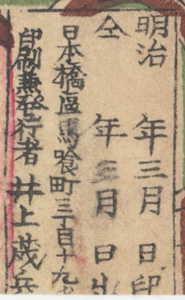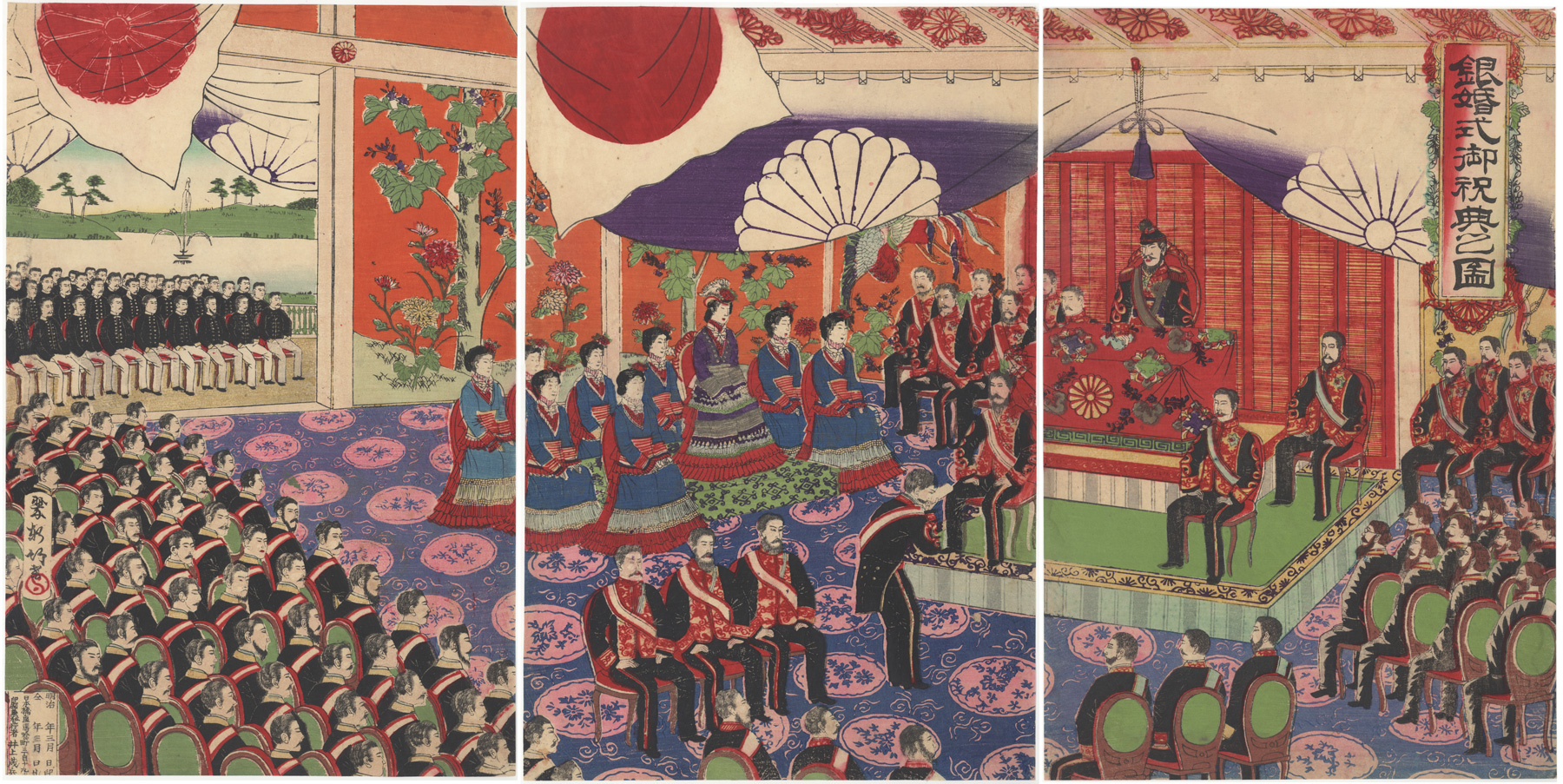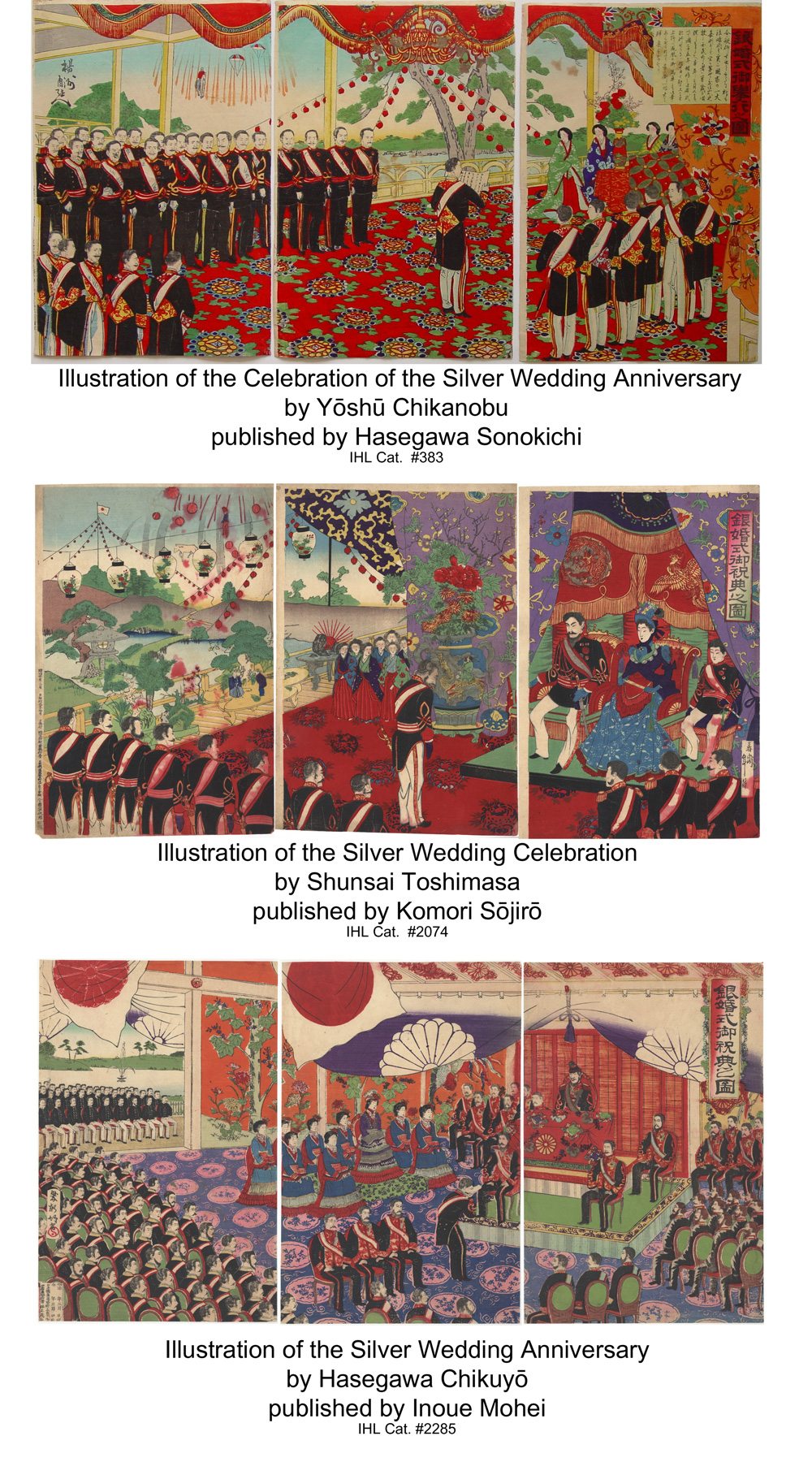About This Print
While there were ceremonies marking the March 9, 1894 Silver Wedding Anniversary (also known as "The Great Imperial Wedding Anniversary") of Emperor Meiji and Empress Shōken which the public could attend, the ceremonies occurring in the public rooms of the Imperial Palace pictured in the above print, and the other two prints in this collection (pictured below), were not open to the public. They were for invited dignitaries only. While it is likely that a few members of the press were invited, it is very unlikely that any of the artists who designed woodblock prints of the event attended, leaving their depictions to their imagination and knowledge of previous prints depicting ceremonies in the palace.
For other prints depicting the Silver Anniversary see IHL Cat. #383 Illustration of the Celebration of the Silver Wedding Anniversary by Yōshū Chikanobu (1838-1912) and Illustration of the Silver Wedding Celebration by Utagawa (Shunsai) Toshimasa (1866-1913).
The Silver Wedding Anniversary of Emperor Meiji and Empress Shōken
Source: The Dawn that Never Comes: Shimazaki Tōson and Japanese Nationalism, Michael Bourdaghs, Columbia University Press, 2010, p. 87.
In discussing the re-definition of the family during the early Meiji years along more Western lines (e.g. monogamous marriage as a new norm), Professor Michael Bourdaghs writes:
[T]he new public ceremonies commemorating marriages and wedding anniversaries for the imperial family played a central role in propagating this new norm [monogamous marriage]. Such ceremonies were part of the nation-state's family discourse, "in which the imperial household and the people were mystically bound together as a family." Despite the fact that the crown prince (the future Taisho Emperor) was the biological son not of the Meiji Empress, but of one of the Emperor's concubines, public ceremonies such as the 1894 Silver Wedding Anniversary provided the image of Emperor and Empress as a stable, monogamous married couple, a model for the nation, because "it was imperative that the family itself be a properly ordered model for the nation."
The wedding anniversaries of Japanese sovereigns had never before been a matter for public rejoicing, but when the emperor was informed that it was customary for royalty in foreign countries to celebrate “silver weddings,” he gladly gave his consent to the proposed celebrations. To make sure the proper tone for the celebration was maintained, a committee was formed to investigate foreign examples.
The Ceremonies
Source: Splendid Monarchy: Power and Pageantry in Modern Japan, T. Fujitani, University of California Press, 1998, p. 113-114.
The core ceremonies...began within the sacred and invisible confines of the Palace Sanctuary, continued into the public rooms of the palace where Japanese and foreign dignitaries observed them, and culminated with an imperial military review at the Aoyama Military Parade Field.
Before noon, the emperor, dressed in his formal military uniform (seiso), and the empress, dressed in a white Western gown, received the felicitations of Japanese and foreign dignitaries. These included over two hundred Japanese princes, peers, and high officials, both civil and military.
Also see the article Prints of Emperor Meiji, Empress Shōken and the Royal Family.
Popularizing the Anniversary Through Woodblock Prints
click on image to enlarge
Three prints from this collection depicting the ceremonies occurring in the "public" rooms of the Imperial Palace
Print Details
| IHL Catalog | #2285 |
| Title or Description | Illustration of Silver Wedding Anniversary 銀婚式御祝典之図 Ginkonshiki goshukuten no zu |
| Artist | Hasegawa Chikuyō (fl. c. 1870-1880s) |
| Signature |  |
| Seal | yin-yang symbol (as shown above) |
| Publication Date | March 1894 [While the month of March is filled in on the below publisher's seal, the year of publication has been left blank, in what is likely an oversight. We can be sure, however, that the print was issued in March 1894, the month and year the Silver Wedding Anniversary of the royal couple occurred.] |
| Publisher |  |
| Carver | |
| Printer | |
| Impression | good |
| Colors | excellent |
| Condition | good - each sheet trimmed into image; unbacked; three separate sheets |
| Genre | ukiyo-e; kaika-e |
| Miscellaneous | |
| Format | vertical oban triptych |
| H x W Paper | right sheet: 13 7/8 x 9 1/8 in. (35.2 x 23.2 cm) center sheet: 13 3/4 x 9 1/8 in. (34.9 x 23.2 cm) left sheet: 13 7/8 x 9 1/16 in. (35.2 x 23 cm) |
| H x W Image | |
| Collections This Print | |
| Reference Literature |
6/13/2020 created



